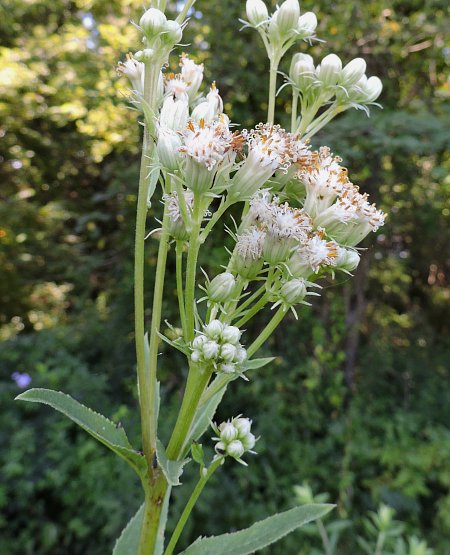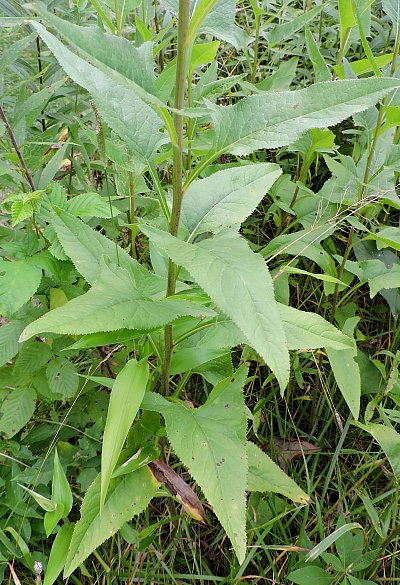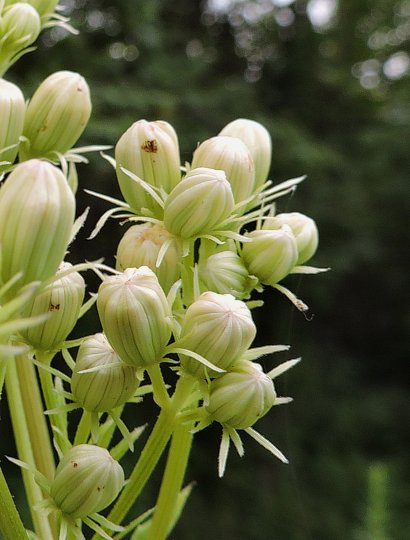Sweet Indian Plantain
Hasteola suaveolens
Aster family (Asteraceae)
Hasteola suaveolens
Aster family (Asteraceae)
Description: This herbaceous perennial plant is 3-7' tall and usually unbranched, except where the inflorescence occurs. The central stem is light green to light reddish green, glabrous to sparsely pubescent, terete, and sometimes shallowly grooved. Sometimes the central stem is also glaucous. The alternate leaves are up to 10" long and 6" across, becoming gradually smaller as they ascend. The lower to middle leaves are hastate or deltate (triangular) in shape and serrated along their margins; the upper leaves are deltate or lanceolate in shape and serrated along their margins. The lower and middle leaves have winged petioles up to 5" long, while the upper leaves are nearly sessile. The tips of leaves are acute to narrowly acute, while their bases are indented, truncate, or broadly wedge-shaped. The basal lobes of hastate leaves are deltate with acute tips. The upper and lower surfaces of the leaves are medium green and glabrous. Leaf venation is pinnate. The central stem and axillary stems from the upper leaves terminate in a panicle (or compound corymb) of flowerheads that is more or less flat-headed. The branches and peduncles of this inflorescence are light green, mostly glabrous, and sometimes glaucous (however, minute hairs may be visible with a hand lens).

Individual flowerheads have 20-40 perfect disk florets and no ray florets; they are 8-12 mm. long and short-cylindrical in shape, although swelling slightly above while blooming. The corollas of the disk florets are white, cylindrical in shape, and deeply 5-lobed above. The base of each flowerhead is surrounded by linear phyllaries (floral bracts) in a single series; these phyllaries are light green to nearly white and glabrous. Underneath the base of each flowerhead, there are several linear bractlets that are widely spreading and up to 8 mm. long. These bractlets are light green to nearly white and glabrous; sometimes their tips curl upward. The blooming period occurs during late summer to early autumn, lasting about 2-3 weeks. The flowerheads have a pleasant sweet fragrance. Afterwards, fertile disk florets are replaced by achenes with tufts of white or tawny hair; they are distributed by the wind and perhaps by water. Mature achenes are about 6 mm. (¼") long, bullet-shaped, and brownish. The root system is shallow and coarsely fibrous. Sometimes clonal offsets develop from the root system.

Cultivation: The preference is light shade to full sun, wet to moist conditions, and soil containing silt, loam, or calcareous sand. This plant can spread aggressively in gardens.
Range & Habitat: Sweet Indian Plantain is uncommon in northern Illinois and rare elsewhere within the state, where it is native (see Distribution Map). Habitats include borders of bottomland woodlands, edges of soggy thickets, river bottom prairies, stream banks, and calcareous fens (including sandy fens). The disturbance of occasional floods along rivers and streams may play an important role in maintaining populations of this species. Such disturbance may reduce competition from less flood-tolerant plants and create areas of exposed topsoil that can be colonized. Sweet Indian Plantain is found in both high quality habitats and more disturbed habitats in floodplain areas.
Faunal Associations: Very little is known about floral-faunal relationships for Sweet Indian Plantain. The nectar and pollen of the flowerheads probably attract a variety of insects, including bees, wasps, flies, small to medium-sized butterflies, skippers, and moths. An aphid (Uroleucon sp.) has been reported to feed on the foliage and plant juices of this plant (Blackman & Eastop, 2013). White-tailed Deer also browse on the foliage (Sharp, 2001).

Photographic Location: A prairie in Fayette County, Illinois. The photographs were taken by Keith & Patty Horn (Copyright © 2015).
Comments: Sweet Indian Plantain (Hasteola suaveolens) has striking triangular-shaped leaves. Because this plant is uncommon throughout its range, it should be cultivated more often. In the past, this plant has been assigned such scientific names as Cacalia suaveolens and Synosma suaveolens. Another common name of this species is False Indian Plantain. It is similar in appearance to some Arnoglossum spp. (Indian Plantain species), including Pale Indian Plantain (Arnoglossum atriplicifolium) and Prairie Indian Plantain (Arnoglossum tuberosum). Sweet Indian Plantain can be distinguished from these species by its deltate and hastate leaves; its flowerheads also have conspicuous spreading bractlets at their bases that these other species lack.